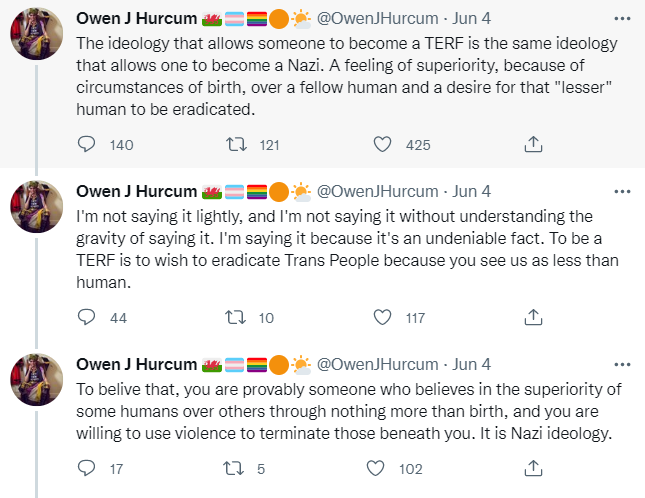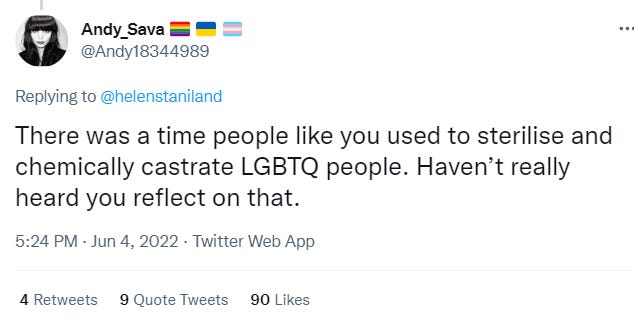Trans activists have long smeared gender-critical women as ‘Nazis’—which has proved a convenient shorthand for “I’m not talking to you and nobody else should listen to a word you say, and—if someone punched your lights out—that would be a win for humanity.” But Corinna Cohn is right to point out that there’s been an alarming escalation in trans activist rhetoric about Nazism, eugenics, euthanasia, and genocide over the last few months, spiking over the weekend with a wildly dishonest attack on two prominent gender-critical women.
e.g.,
Sure, maybe it’s just Godwin’s law in action: baseless Nazi analogies are hard to resist, particularly when you’re a trans activist desperate to return to the days of no debate. But, having spent my teenage years reading everything I could find in an attempt to make sense of 20th-century totalitarianism, I think that what really happened—and how it happened—matters. Trans activists want to talk about Aktion T4, so let’s talk about it. Let’s talk about how ordinary doctors went down the dark road to medical experimentation, sterilization, euthanasia, and genocide.
Nazi ideology captured the medical profession in Germany by enlisting the medical profession in a process of social transformation. The Nazi Party deployed what turned out to be an irresistible metaphor: the German Volk as a body from which certain cancers must be removed to restore health. Nazi ideology called upon doctors to rise above treating individual patients to practice medicine at the societal level. Robert Jay Lifton calls this medicalized killing—killing in the name of healing—and shows how this concept laid the ideological groundwork for the sterilization and euthanasia campaigns and genocide.
The needs and rights of individual patients—the subject of the extensive medical training every doctor who participated in the Nazi killing campaigns had received—got lost. Doctors became desensitized to what they were doing. Uplifting euphemisms covered ugly realities. Euthanasia became a “therapeutic cure” for the national body. (One scholar, who reviewed tens of thousands of medical documents related to the euthanasia program, never saw the word ‘killing’ used once.) Nazi doctors conceptualized the human beings they euthanized or experimented on as—in every sense but one—already dead. Yes, these people still breathed. Their hearts were still beating. But that was all. Since disabled patients were defined as life unworthy of life (Lebensunwertes Leben), what was life to them? Life unworthy of life was a mistake, nothing more. Since the prisoners who fell into the hands of concentration-camp doctors were doomed anyway, what could it possibly matter what happened to their bodies in the mean time? Besides, didn’t the doctors have a responsibility to use these walking corpses to advance medical knowledge? Nothing was off limits.
Medical experts focused narrowly on technical questions, enabling them to ignore human questions: How could certain procedures be conducted more efficiently? What cocktail of drugs or gases brings about the desired outcome with a minimum of complications? (As G. K. Chesterton put it in Eugenics and Other Evils, “they have studied everything but the question of what they are studying.”)
One way of saying this is that doctors—in thrall to a deadly ideology—lost sight of what they were doing. They became wrapped up in medical fantasies and so committed atrocities. And at every step, when it might have been possible to raise questions or veer away from “medicalized killing,” the medical profession doubled down. Turning back risked a reckoning: If euthanizing this set of patients is wrong, maybe it was wrong when doctors killed those other patients, too. By continuing down the road to genocide, the medical profession justified to itself the acts that members had already committed in the name of medicine.
If there are parallels here, they’re inconvenient ones for trans activists. Let’s take up a single thread and leave the rest for the moment.
When it comes to gender medicine, too many affirmative providers conceptualize their patients as defective and broken—just listen to clinicians hand-wave bad outcomes from their interventions. Clinicians argue that their gender-dysphoric patients will never lead normal lives, complete with stable relationships and healthy self-image. Therefore, holding gender ‘medicine’ to too high a standard is unjust (to medical providers). Talk of suicide is everywhere—except in the data itself, which never cooperates. The focus on suicide skews every risk assessment: any outcome is better than suicide—including unethical medical experimentation and butchery.
When doctors define healthy patients as ill—riddled with birth defects (like healthy breasts on a teenage girl), suffering from potentially fatal* (*see suicide inflation) endocrine conditions—then illness and injury already exist, by definition. But, in fact, gender clinicians introduce illness and injury. They injure and sicken patients in the name of health and healing. When that happens, something has gone badly wrong.
One last thing:
Critics of gender identity ideology aren’t the ones sterilizing and chemically castrating LGBTQ people. Gender clinicians even prescribe the same basic types of drugs. They just call sterilization and chemical castration ‘affirmation’ these days. You hardly hear those ugly words at all.
Originally posted on Eliza’s Substack ‘Writing Behavior’






Exactly this Eliza! When the transactivists accuse GC people of being Nazi it looks like classic transference to me.
There's also a mighty thread from Eliza yesterday. It's been widely shared, but just in case - https://twitter.com/elizamondegreen/status/1534586565326143488